I did a necropsy on the motor today and it just got worse the further I got into it.
First, there was nothing in the oil filter out of the ordinary. I cut it open with a sharp chisel since I have no filter cutter. Some copper shimmer color to the oil in it, but nothing big enough you could physically see. I was feeling pretty confident there.
...until I pulled the pan off. Or tried I should say. I used a 1/4" bead of Right Stuff on each side of the windage tray when I put it on with the pan and it made getting the pan off an hour long ordeal and the pan rail on it is definitely toast. This pan is crushed from the car falling off the jack stands anyway, but had i tried to reuse it I'd be working with a hammer and dolly for a while to get everything back straight. In the future I'll use two smaller beads or a single 1/8" bead instead, this just seemed like overkill to get everything apart.
On the inside of the pan below the thrust bearing there was a stripe of ferrous metal, thin shavings of copper, etc.

Things only got worse from here.
Here is the view of the thrust bearing from above. What really puzzled me here was that the thrust bearing was shoved forward, not backward. The bolts from the flywheel that were digging into the rear main cap would have caused the crank to move aft, not forward.
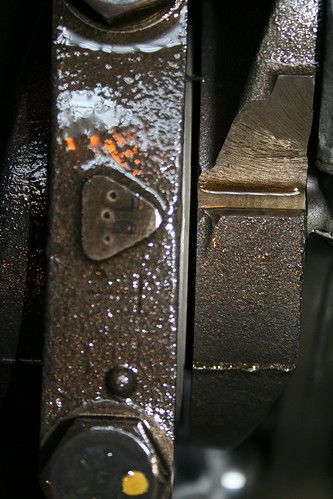
I did a quick thrust endplay check with a short prybar and a dial indicator and it showed .042". My '62 Galaxie shop manual shows .004-.008" with replacement spec at .012"
Pulling the #3 main cap to inspect the carnage...ugh. Bearing is halfway ground off.
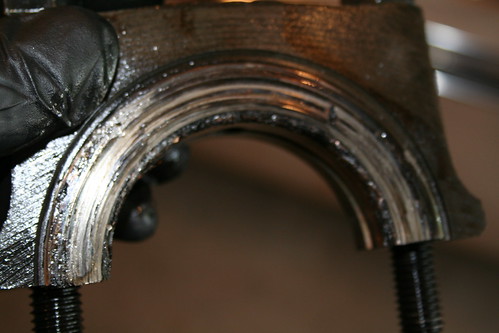
Rear thrust face of #3 crank journal is toast, there is a heavy ridge here you can catch a fingernail on. I'll need to research some more on the max distance allowed between the crank #3 main bearing journal faces here, but I imagine this crank is toast and will need re-welded or just tossed. Totally sucks because this was a very nice 428 crank that I had custom neutral balanced for this motor.
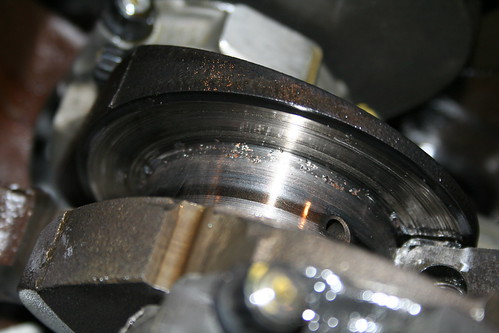
Crank journal is damaged from the bearing particles, you can catch a fingernail on the damage here. This probably wont micro polish out, but it makes no difference since the thrust faces are so bad.

Then things got worse. I started looking into the block to get some views of the cam lobes. Everyone is all sketched out about failing cam lobes, so I figured it was worth a look. This is a Comp custom hydraulic roller from Brent. All the lobes I could see looked a-ok, no discoloring, scuffing or blueing. Then I started looking into the cylinder bores.
Scuffing in the cylinder walls...all of them

The scuffs look as deep as the final honing finish. These are speed pro forged semi-flat top slugs.
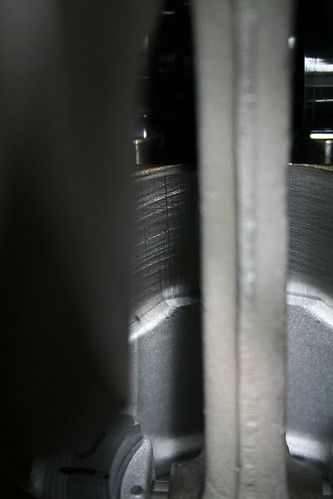
I don't know the reason for this and would like some forum members opinions here. The thrust bearing destruction would have puked the debris out of the bearing into the pan, where it was seen. Is it possible for the thrust bearing debris to make it back into the crank and up the rods expelled out oil lands and into the walls between the piston face and wall? This motor always had good oil pressure and never overheated.
Back to the cause of the crank getting shoved forward in the block, I did mockups of the transmission, bellhousing and motor prior to tearing into the bottom end. The input shaft of the transmission engaged beautifully into the pilot bearing, no binding here. With everything bolted up, minus the clutch assembly, I could reach in through the clutch fork window and easily spin the input shaft. A-OK here, so the input shaft can't be buried into the rear of the crank. I marked the input shaft at where the rear face of the pilot was riding so I could see if it was engaging too.
Looks kinda shallow for where the pilot should be riding...
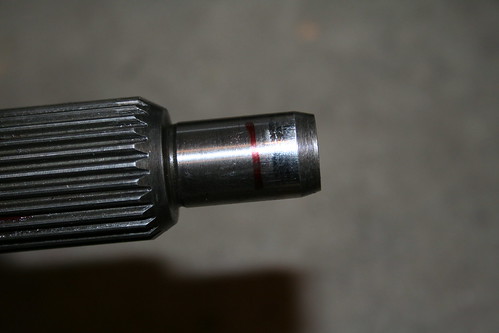
Looking closer at the input shaft, I think the cause of this whole nightmare is the witness marks on the top spline in the photo. They look super shallow as well. When I mocked the clutch disc up on the input shaft on the witness mark, it was only halfway engaged on the splines of the disc at best. I took an hour and took a ton of measurements off the rear of the block, the rear crank, the transmission to verify that this was actually where that clutch disc was engaging and it all adds up. This in itself would have been a disaster on the first clutch dump probably shearing the splines right out of the clutch disc or input shaft. However, when I looked at the corresponding inside of the clutch disc the witness marks were not there. I had the trans in and out of the car a dozen times before I fired the motor adjusting small things in the crossmember and z-bar assembly. These witness marks on the input shaft are likely from when the old 390 and old clutch were still in front of the transmission, making me wonder if the trans always engaged shallow into the clutch, even with the old motor. With only a 1/4" of input shaft splines into the clutch disc, it would have been super easy to not have the splines actually engaged when I thought they were and then tightened the trans up to the bellhousing. It probably bound up the last time I installed the trans to the motor not noticing since it was the last 1/4". This would have put extreme pressure on the rear of the crank. This also would explain why no matter what I did the clutch would not disengage and the transmission would not shift into any gear or reverse.
I think this explains what happen, unless others have opinions as well, I'm all ears. I'm pretty heartbroken, even more so knowing it is my fault despite how careful I try to be with everything. The only lingering question I have is the scuffing of the cylinder walls unless everyone thinks that occurred due to the failed thrust bearing.